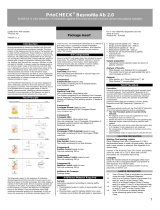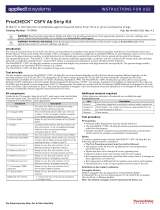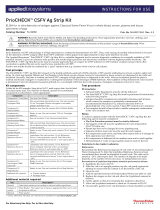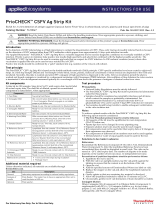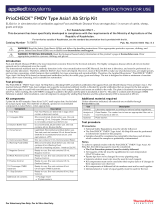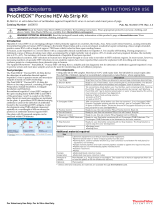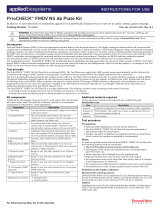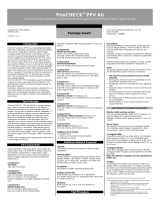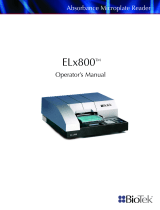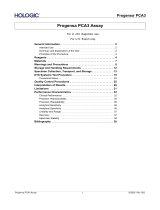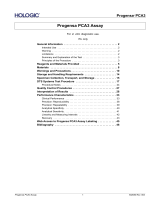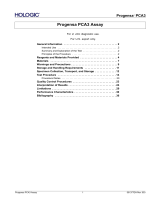Page is loading ...

For Veterinary Use Only. For In Vitro Use Only.
INSTRUCTIONS FOR USE
PrioCHECK™ Porcine Trichinella Ab Strip Kit
ELISA for
in vitro
detection of antibodies against
Trichinella
spp. in serum and meat juice of pigs
Catalog Number 7610150
Pub. No. MAN0013850 Rev. C.0
WARNING! Read the Safety Data Sheets (SDSs) and follow the handling instructions. Wear appropriate protective eyewear, clothing, and
gloves. Safety Data Sheets (SDSs) are available from thermofisher.com/support.
WARNING! POTENTIAL BIOHAZARD. Read the biological hazard safety information at this product’s page at thermofisher.com. Wear
appropriate protective eyewear, clothing, and gloves.
Introduction
Trichinellosis caused by the Nematode Trichinella is a zoonotic disease which occurs worldwide and affects a broad range of different species including
mammals, birds and amphibians. Currently 11 different subspecies (8 designated as species) have been recognized in this genus. The species that are of
main importance in Europe are Trichinella spiralis, Trichinella britovi, Trichinella pseudospiralis, and Trichinella nativa. Trichinella spiralis is found in
production animals (pigs, horses) in temperate climate zones and can also be found in animals in close contact with these production animals (e.g. dogs,
cats, rats). Trichinella britovi is mainly found in wildlife. Trichinella pseudospiralis is distributed worldwide and is also found in birds. Trichinella infections
of pigs are of major concern since humans can be infected by eating raw or insufficiently cooked meat.
The Applied Biosystems™ PrioCHECK™ Porcine Trichinella Ab Strip Kit is a reliable and fast diagnostic test for detection of antibodies against Trichinella
in porcine serum and meat juice samples and can be used for monitoring and surveillance purposes.
Test principle
The diagnostic assay for the detection of
antibodies directed against Trichinella spp in
serum and meat juice samples of pigs is based
on ELISA technology. E/S antigen as the major
antigenic protein complex is coated on the
ELISA plate. Serum or meat juice samples are
incubated on the plate. A Protein G antibody is
used for the detection of antibodies bound to the
E/S antigen. Color development using TMB
substrate measured optically at a wavelength of
450 nm shows the presence of antibodies
directed against Trichinella spp.
The PrioCHECK™ Porcine Trichinella Ab Strip
Kit follows a four step protocol, consisting of
Sample Preparation, Sample Incubation,
Conjugate Incubation, and Detection. One plate
with 90 prepared samples can be analyzed
within 90 minutes.
Kit components
5 plate kit for 450 samples. Store kit at 5±3°C until expiry date. See kit label for actual expiry date.
The shelf life of diluted, opened or reconstituted components is noted below, where appropriate.
Component
Description
1: Test Plate
Strip Plate. Five Test Plates are delivered in vacuum bags containing a desiccant
bag.
2: Sample Diluent
Ready-to-use. Two bottles containing 60 mL of Sample Diluent. The Sample Diluent
is used to dilute the samples. Color of solution: yellow.
3: Washing Fluid (20x)
20x concentrate, dilute before use. Two bottles containing 60 mL Washing Fluid
(20x). Prepare Washing Fluid working solution by mixing 1 part Washing Fluid (20x)
with 19 parts demineralized water or water of equal quality and 0.2 parts of
Washing Fluid Additive (equals 1%). Mix until a clear solution is obtained.
Remark: If the Washing Fluid (20x) shows a precipitate, warm the bottle in a 30°C
water bath until the precipitate is completely redissolved. Stability of Wash Fluid
working solution: 2 weeks at 22+3°C.
4: Washing Fluid Additive
One bottle contains 30 mL Washing Fluid Additive. 1% Washing Fluid Additive has to
be added to the diluted washing fluid. Mix until a clear solution is obtained.
Remark: Viscous liquid.
5: Conjugate Diluent
Ready-to-use. One bottle contains 60 mL Conjugate Diluent. The Conjugate Diluent
is used to dilute the Conjugate. Color of solution: red.
6: Conjugate (30x)
30x concentrate, dilute before use. One bottle containing 2 mL Conjugate. Prepare
1x Conjugate by mixing 1 part of Conjugate with 29 parts of Conjugate Diluent.
Dilute the amount of Conjugate necessary to run the test, just prior to use.
7: Chromogen (TMB)
substrate
Ready-to-use. One bottle containing 60 mL Chromogen (TMB) substrate. The
Chromogen (TMB) substrate is the substrate for the color reaction.
8: Stop Solution
Ready-to-use. One bottle containing 60 mL Stop Solution. The Stop Solution is used
to stop the color development.
9: Demineralized Water
One vial containing 10 mL Demineralized Water. Demineralized Water is used to
reconstitute the lyophilized control samples.
10: Positive Control
Lyophilized. One vial containing the lyophilized Positive Control. The Positive
Control is reconstituted by adding 150 µL of Demineralized Water (supplied with the
kit). Mix by vortexing thoroughly and inverting the vial several times. Store at −20 to
−80°C after reconstitution. Can be aliquoted or may be freeze-thawed up to 5 times.
11: Weak Positive Control
Lyophilized. One vial containing lyophilized Weak Positive Control. The Weak
Positive Control is reconstituted by adding 150 µL of Demineralized Water (supplied
with the kit). Mix by vortexing thoroughly and inverting the vial several times. Store
at −20 to −80°C after reconstitution. Can be aliquoted or may be freeze-thawed up
to 5 times.
Note: Use of this control is optional.
12: Negative Control
Lyophilized. One vial containing lyophilized Negative Control. The Negative Control
Sample is reconstituted by adding 150 µL of Demineralized Water (supplied with the
kit). Mix by vortexing thoroughly and inverting the vial several times. Store at −20 to
−80°C after reconstitution. Can be aliquoted or may be freeze-thawed up to 5 times.
Additional kit contents
Package Insert

2 PrioCHECK™ Porcine Trichinella Ab Strip Kit Instructions for Use
Additional material required
Use
Description(1)
General
Laboratory equipment according to national safety regulations.
• Demineralized or water of equal quality must be used
• Dummy plate, used for sample dilution (e.g. clear colorless
round bottom 96 well plates) or equivalent
• Single channel pipette (10–100 µL)
• Single channel pipette (20–200 µL)
• Multichannel pipette (5–50 µL)
• Multichannel pipette (50–300 µL)
• Pipette tips (as recommended by pipette manufacturer)
• Solution reservoirs
• Vortex
Sample
preparation
• Dedicated blood collection tubes
• Dedicated meat juice collection tubes
Analysis of
results
Plate Reader, e.g. Tecan Sunrise or equivalent. The reader has to
have an appropriate filter set to read the plates at 450 nm.
Optional
Plate washer.
(1) Unless otherwise indicated, all materials are available through thermofisher.com.
Test procedure
Precautions
• National Safety Regulations must be strictly followed.
• The PrioCHECK™ Porcine Trichinella Ab Strip Kit must be performed
in laboratories suited for this purpose.
• Samples should be considered as potentially infectious and all items
which contact the samples as potentially contaminated.
Notes
To achieve optimal results with the PrioCHECK™ Porcine Trichinella Ab
Strip Kit, the following aspects must be considered:
• The Test Procedure protocol must be strictly followed.
• Pipette tips have to be changed for every pipetting step.
• Separate solution reservoirs must be used for each reagent.
• Kit components must not be used after their expiry date or if changes
in their appearance are observed.
• Kit components of different kit lot numbers must not be used together.
• Demineralized water or equal must be used for the test.
Sample preparation
• Serum can be obtained using standard methods.
• If meat juice is tested, a piece of muscle tissue e.g. 10 g (preferable tongue,
diaphragm or masseter) is either freeze-thawed in a dedicated device or
alternatively the piece of meat can be squeezed to obtain meat juice.
Reconstitution of control samples
1. Reconstitute the control sample by adding 150 µL of Demineralized
Water (delivered with the kit).
2. Mix by vortexing thoroughly and inverting the vial several times or
use already reconstituted control samples that have been stored at
−20°C to −80°C.
Sample dilution for serum samples
1. Use a Dummy Plate or equivalent for first sample dilution (see Table 1).
2. Add 10 µL of Positive Control to wells A1 and B1 of the Dummy Plate.
3. Add 10 µL of Negative Control to wells C1 and D1 of the Dummy Plate.
4. (Optional) Add 10 µL of Weak Positive Control to wells E1 and F1 of the
Dummy Plate.
5. Add 10 µL of serum samples to the remaining wells of the Dummy Plate.
6. Add 90 µL of Sample Diluent to each well of the Dummy Plate and
mix by pipetting up and down 5 times.
7. Add 80 µL of Sample Diluent to each well of the Test Plate.
8. Transfer 20 µL of the diluted samples and controls from the Dummy
Plate to the corresponding wells of the Test Plate and mix by pipetting
up and down 5 times.
Sample dilution for meat juice samples
1. Use a Dummy Plate or equivalent for first sample dilution (see Table 1).
2. Add 10 µL of Positive Control to wells A1 and B1 of the Dummy Plate.
3. Add 10 µL of Negative Control to wells C1 and D1 of the Dummy Plate.
4. (Optional) Add 10 µL of Weak Positive Control to wells E1 and F1 of
the Dummy Plate.
5. Add 90 µL of Sample Diluent to each control in the Dummy Plate.
6. Add 100 µL of meat juice sample to the remaining wells of the
Dummy Plate.
7. Add 80 µL of Sample Diluent to each well of the Test Plate.
8. Transfer 20 µL of the samples and diluted controls from the
Dummy Plate to the corresponding wells of the Test Plate.
Sample incubation
1. Incubate the samples on the Test Plate for 30±1 minutes at room
temperature (22±3°C).
2. Wash the Test Plate four times with 300 µL 1x Wash Fluid working
solution.
Remark: If you use a plate washer be sure that no needles are clogged.
Conjugate incubation
Preparatory steps
• Dilute the needed amount of Conjugate (30x) 30 fold in Conjugate
Diluent (e.g. add 400 µL Conjugate to 11.6 mL Conjugate Diluent for
one full plate.
Conjugate incubation
1. Add 100 µL of the diluted Conjugate to each well of the Test Plate.
2. Incubate the Test Plate for 30±1 minutes at 22±3°C.
3. Wash the Test Plate four times with 300 µL 1x Wash Fluid working
solution.
Detection
Substrate reaction
1. Add 100 µL of the Chromogen (TMB) substrate to each well on the
Test Plate.
2. Incubate the Test Plate for 15±1 minutes at 22±3°C.
3. Add 100 µL of the Stop Solution to each well of the Test Plate.
Remark: Start the addition of stop solution 15±1 minutes after the first well
was filled with Chromogen (TMB) Substrate solution. Add the Stop Solution in
the same order as the Chromogen (TMB) Substrate solution was dispensed.
Note: The color of the Positive Controls will change from blue to yellow.
Detection
1. Shake the Test Plate shortly (5–10 s) either on an orbital shaker
(~300 rpm) or manually on the working bench.
2. Read the Test Plate in the ELISA reader at 450 nm within 15 minutes.
Recommendation: Use a reference filter at 620 nm.
Result interpretation
Calculation of results
PP = (OD450 Sample / OD450 Positive Control) × 100
Validation criteria
1. The mean OD450 of the Positive Controls must be >1.0.
2. The mean OD450 of the Negative Controls must be <0.2.
3. If the Weak Positive Control was used, the mean percentage of
positivity (PP) of the Weak Positive Controls must be >35%.
If these criteria are not met, the results are invalid and the samples have to
be retested.
Interpretation of results
• Results obtained above or equal the cut-off of 15 PP are considered
positive.
• Results obtained below the cut-off of 15 PP are negative.
Recommended plate layouts
The following plate layouts allow for efficient transfer of pre-diluted samples
and controls from the Dummy Plate to the Test Plate (P — Positive Control;
N — Negative Control; W — Weak Positive Control (optional); S — Sample).
Table 1 Plate layouts: Dummy Plate and Test Plate
1
2
3
4
5
6
7
8
9
10
11
12
A
P
S
S
S
S
S
S
S
S
S
S
S
B
P
S
S
S
S
S
S
S
S
S
S
S
C
N
S
S
S
S
S
S
S
S
S
S
S
D
N
S
S
S
S
S
S
S
S
S
S
S
E
W or S
S
S
S
S
S
S
S
S
S
S
S
F
W or S
S
S
S
S
S
S
S
S
S
S
S
G
S
S
S
S
S
S
S
S
S
S
S
S
H
S
S
S
S
S
S
S
S
S
S
S
S

thermofisher.com/support | thermofisher.com/askaquestion
thermofisher.com
12 September 2023
Customer and technical support
Technical support: visit thermofisher.com/askaquestion
Visit thermofisher.com/support for the latest in services and support,
including:
• Worldwide contact telephone numbers
• Order and web support
• User guides, manuals, and protocols
• Certificates of Analysis
• Safety Data Sheets (SDSs; also known as MSDSs)
NOTE: For SDSs for reagents and chemicals from other manufacturers,
contact the manufacturer.
Limited product warranty
Life Technologies Corporation and/or its affiliate(s) warrant their
products as set forth in the Life Technologies' General Terms and
Conditions of Sale found on Life Technologies' website at
www.thermofisher.com/us/en/home/global/terms-and-conditions.html.
If you have any questions, please contact Life Technologies at
thermofisher.com/support.
Prionics Lelystad B.V. | Platinastraat 33 | 8211 AR Lelystad | The Netherlands
The information in this guide is subject to change without notice.
DISCLAIMER: TO THE EXTENT ALLOWED BY LAW, LIFE TECHNOLOGIES AND/OR ITS AFFILIATE(S)
WILL NOT BE LIABLE FOR SPECIAL, INCIDENTAL, INDIRECT, PUNITIVE, MULTIPLE, OR
CONSEQUENTIAL DAMAGES IN CONNECTION WITH OR ARISING FROM THIS DOCUMENT,
INCLUDING YOUR USE OF IT.
Revision history of Pub. No. MAN0013850 (English)
Rev.
Date
Description
C.0
12 September
2023
• The peroxidase (POD) labeled anti-pig antibody was changed to
protein G antibody (see Test principle).
B.0 21 August 2020
• Updated the protocol to make the use of the Weak Positive Control
optional.
• Added a section for recommended plate layouts.
A.0 18 March 2019
New document. Converted the legacy document (PrioCHECK
Trichinella_7610150_v1.4_e.doc) to the current document template,
with associated updates to the publication number, limited license
information, warranty, trademarks, and logos.
Important Licensing Information: These products may be covered by one or more Limited Use
Label Licenses. By use of these products, you accept the terms and conditions of all applicable
Limited Use Label Licenses.
©2023 Thermo Fisher Scientific Inc. All rights reserved. All trademarks are the property of Thermo
Fisher Scientific and its subsidiaries unless otherwise specified.
/
